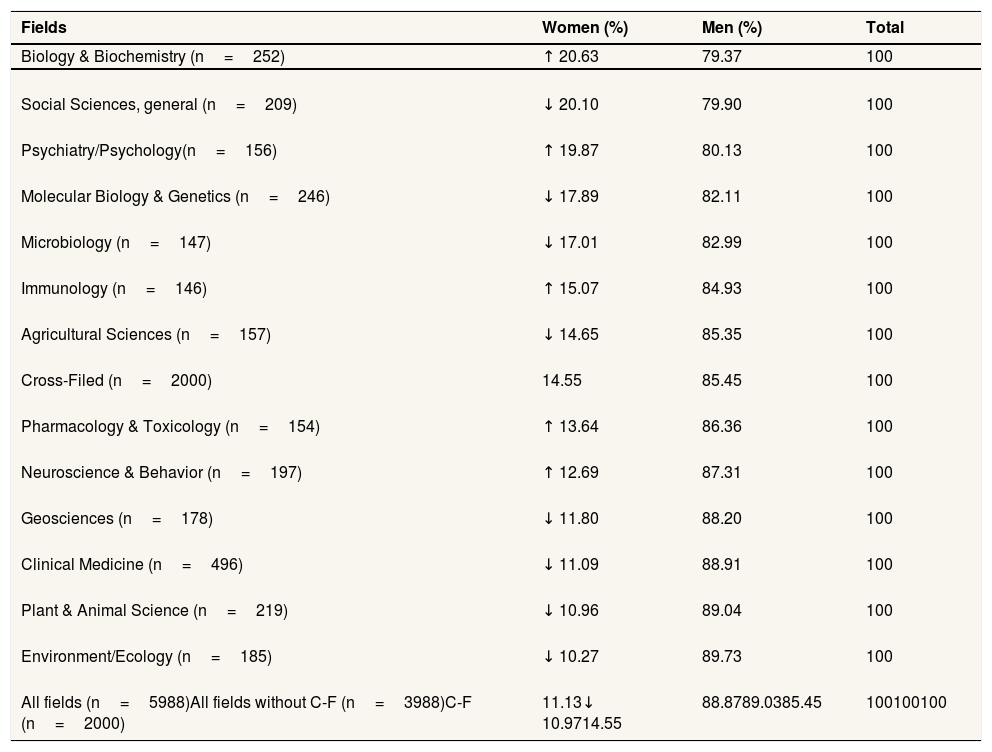In 2018, «for the first time, Highly Cited Researchers —a list of elite scientists and social scientists identified through analysis of highly cited papers(those ranking in the top 1% by citations for field and year in Web of Science)— a new Cross-Field category to identify researchers with substantial influence across several fields but who do not have enough highly cited papers in any one field to be chosen during the last decade was introduced».1 Given that highly cited researchers (HCR) have the greatest share in the highest cited papers, we selected them for our study. Total of 6079 HCR, 2020 researcher located in the Cross-field (C-F). Although previous studies have examined the gender distribution of HCR in 2014.2 However, due to the nature of new the interdisciplinary category (C-F) and the category has not been studied, we conducted this scientometric study to showing of representation of women in HCR with focused on C-F category.
We aimed to reduce the error in determining the authors’ gender, HCR were searched manually and their gender was identified by personal, academic, institutes and scientific centers, Google Scholar and ResearchGate. Researchers were divided into groups A (HCR on the main categories) and group B (HCR on C-F category).
Gender of HCR identified (98.25%) in the group A and group B was 3988 (98.25%) and 2000 (99%), respectively. Group A including 89.03% male and 10.97% female and group B has 85.45% male and 14.55% female. The results showed that (without C-F category), women in two-thirds of the categories had a slower growth compared to previous results2 (Table 1). Also, results showed that there is a significant relationship between gender of women and categories (p <0.001), so that a higher percentage of C-F women (14.55%) than to main fields for women were women (10.97%). Also, women were 30% more likely to be in the C-F than men.
Distribution of highly cited researchers in individual fields compared to previous results.2
| Fields | Women (%) | Men (%) | Total |
|---|---|---|---|
| Biology & Biochemistry (n=252) | ↑ 20.63 | 79.37 | 100 |
| Social Sciences, general (n=209) | ↓ 20.10 | 79.90 | 100 |
| Psychiatry/Psychology(n=156) | ↑ 19.87 | 80.13 | 100 |
| Molecular Biology & Genetics (n=246) | ↓ 17.89 | 82.11 | 100 |
| Microbiology (n=147) | ↓ 17.01 | 82.99 | 100 |
| Immunology (n=146) | ↑ 15.07 | 84.93 | 100 |
| Agricultural Sciences (n=157) | ↓ 14.65 | 85.35 | 100 |
| Cross-Filed (n=2000) | 14.55 | 85.45 | 100 |
| Pharmacology & Toxicology (n=154) | ↑ 13.64 | 86.36 | 100 |
| Neuroscience & Behavior (n=197) | ↑ 12.69 | 87.31 | 100 |
| Geosciences (n=178) | ↓ 11.80 | 88.20 | 100 |
| Clinical Medicine (n=496) | ↓ 11.09 | 88.91 | 100 |
| Plant & Animal Science (n=219) | ↓ 10.96 | 89.04 | 100 |
| Environment/Ecology (n=185) | ↓ 10.27 | 89.73 | 100 |
| All fields (n=5988)All fields without C-F (n=3988)C-F (n=2000) | 11.13↓ 10.9714.55 | 88.8789.0385.45 | 100100100 |
Given that C-F researchers active in several fields in certain data, it seems our finding about of distribution of gender on the C-F category may be related with multitasking,3 task switching,3 and focus on activities4 and be helpful for explaining these issues in gender difference. Although the representation of women authors in productions is lower than men5 and gender gaps is expanding between HCR, the findings showed that a more promising situation in C-F category for women. As well as, our findings mentioned that alarming status for non-medical and health fields for HCR females compared to previous study2 and the growth of male-dominated in these categories. However, although women have fewer publications than men, their quality and impact in scientific output should not be overlooked.5
Authorship contributionsThis paper has a one author (A. Shamsi).
We would like to thank Clinical Research Development Center, Shohadaye Khalije Fars Hospital, Bushehr University of Medical Sciences, Bushehr, Iran and Dr N. Mohammad Gholi Mezerji for statistical analysis.















